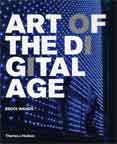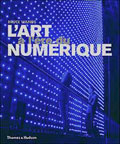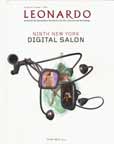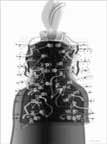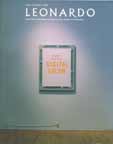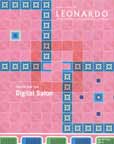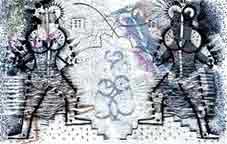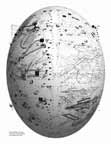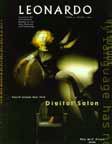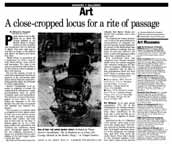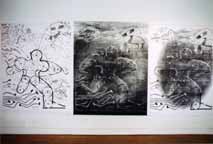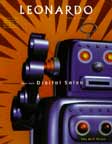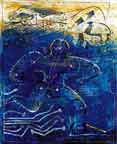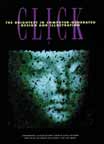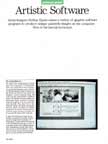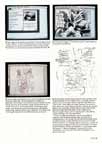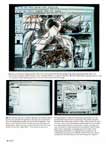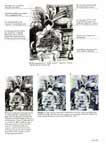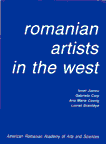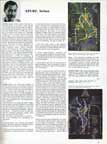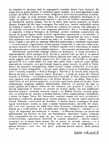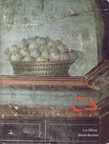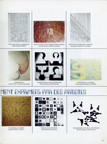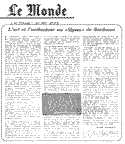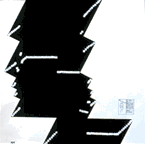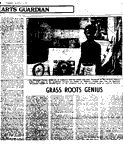2014 (in preparation)![]()
THE MUSEUM... series
With the appearance and the democratization of the computer, in the 1960s, many artists, happy to seize this object and to make it a new artistic medium, emerged. Images, collages, 3d, videos, Net Art, software art, interactive objects, multimedia facades... digital art, in perpetual renewal, can take many forms. Organized around thematic chapters (Images, Sculptures, Videos etc.), the digital MUSEUM presents 70 of these innovative artists.image section
• Paul Brown • Bruce Wands • Leon Harmon et Ken Knowlton • Sherban Épuré • Jean-Pierre Hébert • Manfred Mohr • Michael Trott • Roman Verostko • Charles A. Csuri • Jean-Pierre Hébert • Margret Eicher • Mark Wilson • Vera Molnar • Yoshiyuki Abe...
2010
• "Computer versus pencil: practice, research, theory" [p. 17]
Anna Ursyn, PhD Professor, School of Art and Design, University of Northern Colorado, USA
ursyn@unco.edu ursyn.com
• "The artist as critic : art writing in Scotland 1960-1990" [p. 71]
Thompson, Susannah Catherine, PhD thesis.

2009
“S-BANDS” AN EXHIBITION OF ANALOG AND DIGITAL ART
Bruce Wands, Curator, Chair of the MFA Computer Art Department at the School of Visual Arts, New York
2008

ART REVIEW
Feast for the eyes and mind
Computer-generated images began more than 50 years agoBy Alan G. Artner | Tribune critic
January 31, 2008The first "must-see" exhibition of 2008 is a survey of a kind of art that began more than a half century ago and has thrived in recent decades though has not had an overview in the Chicago area before this revelatory effort that occupied organizers eight years.
"Imaging by Numbers: A Historical View of the Computer Print," at Northwestern University's Mary and Leigh Block Museum of Art, presents the development of a way of working that grew from the optimism of 1950s mathematicians and engineers and, despite the perpetual clamor for something "new" in the art world, has remained cutting edge.
....
All of the 39 North American and European artists represented have used clear step-by-step procedures to get computers to draw images.
....
Still, visual complexity remains an unspoken standard, so even when more recent works appear abstruse (Hans Dehlinger, Sherban Epure, Jason Salavon) they feed the eye as well as nourish the mind.
2006
Bruce Wands, Art in the Digital Era, (London , Thames and Hudson) pp. 10 & 33.
This aptly named book provides a broad overview and sampling of digital art. Editor Wands (chair, master of fine arts computer art department, Sch. of Visual Arts; Digital Creativity) ably traces the history of digital art, then outlines in several chapters various areas of the field—digital imaging; digital sculpture; digital installation and virtual reality; performance, music, and sound art; software, database, and game art; “net art”; and the future of digital art. Each chapter includes a sampling of photographs by emerging and established artists, although the field is so new that it appears to be difficult to make an honest distinction.
Dans une édition claire et richement illustrée, l’artiste et professeur Bruce Wands expose les enjeu actuels de l’art numérique, et ses modes d’application : image, vidéo, sculpture, installation ou performance.
SHERBAN EPURÉ, "CONDOTIERRE", 2003. Inkjet, Print, Variable Dimmensions.
Sherban Epuré uses the term "meta-phorms" to describe the results of his mathematically based image-generating process. This work produced using algorithms, is formed by interaction of colour with a simple geometric shape. One intent of Epuré's imaging is to forge a link between Western technology and Eastern spirituality. page10.
... New digital techniques can be considered as the latest step in an evolutionary process; where traditional drawing and painting methods are constrained by the limitations of physical technique, and photography and video rely on lens-based technologies, digital imaging incorporates elements of mathematical computation and mechanical precision, making possible a whole range of styles from photorealism to pure mathematical abstraction.
The earliest digital printmakers needed to programme the computer before making their drawings because first-generation graphics software did not have interface. After programming, images were output through the use of plotters-devices that draw pictures on paper with a variety of pens or brushes controlled by digital motors. The use of programming to create images continues to the present day, and artist such as Paul Brown (pp. 44-45), Sherban Epuré (p.10), Jean-Pierre Hébert (pp.13,38), Manfred Mohr (pp. 25,63), Michael Trott and Roman Verostko (p.70) all use programming as an integral part of their creative process. ... page33.
![]()
2001
Leonardo, vol.34, #5, the MIT Press, The Ninth New York Digital Salon.

![]()
2000
• Who's Who in America, Romanians in America, Danway Publications, Montreal, Canada.
• Leonardo, vol.33, #5, the MIT Press. The Eighth New York Digital Salon.
![]()
1999
Leonardo, vol.32, #5, the MIT Press. The Seventh New York Digital Salon.
![]()
1997
• Kirsten Solberg, Critical note, at the Fifth Annual New York Digital Salon.
Epuré has created a composition that visually astonishes and intrigues the viewer. He begins with "mathematical essences" that then creates his art through a process that he terms a "surprising virtual nature".
His algorithms"create his images". His goal is to bring about a meeting of Western technology and Eastern spirituality.• Leonardo, vol.30, #5, the MIT Press. The Fifth New York Digital Salon.
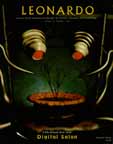
![]()
1996
• Leonardo, vol.29, #5, the MIT Press. The Fourth New York Digital Salon.
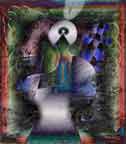
• Edward Sozanski, The Galleries' Review, The Philadelphia Inquirer, February 16, Philadelphia.
"Epuré, who is also in the Silicon Gallery show, is a pure computer artist, and an unusually imaginative one. His large laser prints express a strong computer-generated personality but they also indicate that Epuré thinks primarily like a painter, not a computer jock."
• A letter from Prof. Dr. Georg Nees, Erlangen, Germany:
..." The material you sent me is that rich and important, that it has gotten an extra file in my private library. What was the real surprise o course, is the copy of Connaissance des arts - 264 - fevrier 1974, proving our that early companionship in exhibiting computer art. So you are a real pioneer of computer art!!!
What I admire highly, is your ability to invent innovative canons of form. Your handling of the circle segment not only as syntactic basic element, but your using it as the esthetic skeleton for designing even the human gestalt, this is amazing... So you have found yourself your personal language and writing of form, what is a rare event, I think. The collection of pages, labeled by "Research of primitives as an intersection of a flux of stimuli and a curve with feedback", this was and is my favorite"...
![]()
1995
• Leonardo, vol.28, #5, the MIT Press 1995. The Third New York Digital Salon.
1990
• Click, the brightest in computer generated illustrations, North Light Books, Cincinnati, OH.
![]()
1989
• Louisa Simone, Artistic Software, How Magazine, Ianuary/ February, NY.
• Mariel Garza, Electronics, oil paint and art, Mac Week, May 23.
![]()
1988
• Verbum Magazine, Gallery, July, San Diego, CA.
• How Magazine, July, NY.
• Step by Step Graphics, March/April.
![]()
1986
• Ionel Jianou, Romanian Artists in the West, Artist presentation, Paris, France, published by the American Romanian Academy of Arts and Sciences, USA:
..."Due to his sound scientific and philosophical training, his gifts as a painter and his determination, Sherban Epuré is prominent in the field of research aiming to transpose technological invention into artistic creation."
![]()
1975
Dan Haulica, Hard Rigor, Secolul 20, #4, Bucharest:
..."mathematical elaborations of forms by Sherban Epuré homologated by outstanding foreign commentators as " fundamental research" deriving from certain forerunners like Pierro dela Francesca, for instance."...
![]()
1974
• Georges Charbonnier, L'ordinateur au service de l'art, Connaissance des Arts, #264, Paris:
..."Final conclusion: the progress in handling and creating programs is constant. So far a genuine suppleness is being conferred to the instrument. The results obtained by the Romanian researcher Sherban Epuré are most significant in this respect." page 73.
Click for a magnified view.
• Iulian Mereuta, Romanian Art Throughout the World, Arta #9, Bucharest.
• Ruxandra Garofeanu, The 8th Bienniale of Paris, Arta #6, Bucharest.
• Horia Horsia, Profile-Sherban Epuré, Flacara, June, Bucharest.
• George Cosma, The Year XXX, Arta #5, Bucharest.
![]()
1973
• Jacques Lonchampt, Art and Computer at Sigma of Bordeaux, Le Monde, November 30, Paris:
.."Alongside the fundamental works like Sherban's Epuré analysis of marked outlines which call in mind Leonardo da Vinci's famous drawings books... One can see here the point of contact of an artistic idea in the programmed intersection of two notions."
![]()
1971
• Constantin Prut, The 7th Biennial of Paris, Contemporanul, September 3, Bucharest.
• Sherban Epuré - Profile, the catalogue of the 25th Edinburgh International Jubilee Festival at the Richard Demarco Gallery, Edinburgh:
"There is the cybernetic 2 and 3 dimensional work by Sherban Epuré which will form, themselves into a little room for the exhibition - a complete environment with original music by Aurel Stroe. Epuré is the rare bird, the mathematician and the poet in one."
• Radu Varia, At Edinburgh"the Romanian Week, Contemporanul, September 3, Bucharest.
• Cordelia Oliver, Grass Roots Genius, The Scotsman, September 1 Edinburgh.
• Edward Gage, Demarco stages rewarding and virile folk art, The Scotsman, August 30, Edinbourgh.
..."There are also some clever improvisations with folded and... striped paper by Sherban Epuré"...
• Cordelia Oliver, Contemporary Romanian Art, The Scotsman, August 23, Edinburgh:
..."Epuré's more or less infinitely variable program of folding colored striped paper - "the more you fold, the more the form of the band changes, the colored stripes are destroyed and recomposed" - offers a way of exploring form that is both universally simple and yet capable of yielding complex and fascinating results."
• Radu Varia, Letter from Bucharest, Studio International, July/August London:
..."Another artist, Sherban Epuré from Bucharest, has studied since 1969 the problem of aesthetic message and the cybernetic character of the relationship between man and a work of art. At the same time he has composed an aesthetic structure (S-Band) capable of suggesting a cybernetic interaction brought about by handling it. The bands can be imagined as small machines for inventing art forms, but which invent more the greater the interest of the person working with them. This interest increases in turn with the exploration of the band."...
• Dominique Guerst, Romania, Opus International # 23, Paris.
..."Sherban Epuré se perd dans les metamorphoses d'un petit rectangle qu'il deplie, deforme, transforme. Son materiel: un carton, 4 cotes, 2 faces, et une infinite de pliures possibles, infini limite a trouver. Ses realisations: de grandes toiles, projections de ses maquettes de depart, propositions abstraites, un seul ordre inlassablement decompose, recompose."...
• Georges Boudaille, The Vanguard in Romania, Lettres Francaises, # 2369, Paris:
..."Autre rencontre, celle de Sherban Epuré qui est venu m'expliquer les possibilites infinie de ses pliages. Pour un pli, il y a trois positions du triangle (voir illustration). Lorsque le nombre d'elements croit, le nombre des combinaisons possible devient aleatoire. Il s'agit la, evidemment, de recherches purement theoriques que Epuré visualise par un jeu de bandes colorees, en presentant un certain nombre de combinaisons sous des pochettes plastiques soudees en une bande qui descend du mur et parcourt le sol. Recherche formelle de mathematicien dont les applications plastiques sont evidentes"...
• Adrian Rogoz, Arta Programativã, Stiinta si Technica, June, Bucharest.
• Octavian Barbosa, Vanguard and Anachronism, Contemporanul, April 16, Bucharest.
![]()
1970
• Cristina Anastasiu, Two Young Exhibitors, Romania Libera, March 3, Bucharest.
• Octavian Barbosa, Sherban Epuré - Diet Sayler, Contemporanul, February 20, Bucharest.
• Elisabeth Axmann, Struktur und Expansionstendentz, Neuer Weg, February 19.
1967--1969
Various articles by: P. Comarnescu, N. Argintescu - Amza, I. Mereutã, E.Schileru, R. Rupea, Cr. Anastasiu.
